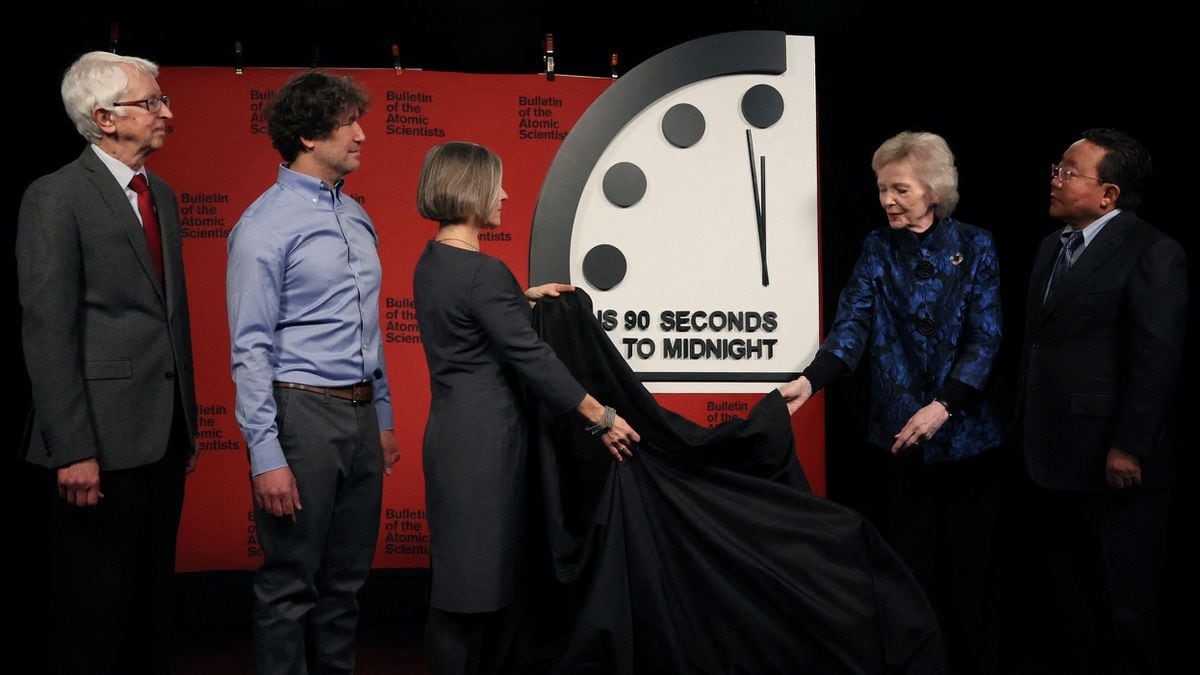There are 90 seconds left until the end of the world. Before running to the nuclear shelter, you should know that, although disturbing, this is nothing more than a symbolic calculation carried out each year by a committee convened by the Bulletin of Atomic Scientists. It is one of those traditions (like the January slope, the dry January commitment to abstinence or Blue Monday) that make the first of the year the cruelest month, and it consists of revealing how close these experts consider humanity to be in the Apocalypse Clock (Doomsday Clock) at midnight, a euphemism behind which total extermination is hidden. The closer, the less there would be left for the end of the world. The good news is that the hands remain the same distance apart as last year. The bad news: 2023 was the most worrying record since the clock was started back in 1947.
The reasons for concern? The custodians of the hands of the apocalypse cited this Tuesday in the presentation in Washington of their conclusions the rise of artificial intelligence, the proliferation of nuclear weapons, the war between Russia and Ukraine and the one waged by Israel in Gaza, biological threats, climate crisis and the rampant misinformation promoted in many cases by the States themselves. At the event, which began, alas, late, they had the popular science communicator Bill Nye, and the leading voice was Rachel Bronson, president and CEO of the Bulletin of Atomic Scientists. She explained that it is about answering two questions: “Is humanity safer or is it at greater risk this year than last year?” And: “Is humanity safer or more at risk this year, compared to the more than 75 years we have been carrying out this exercise?”
It is not a stable world
Bronson also asked that no one be fooled: “Setting the clock at 90 seconds to midnight is not an indication that the world is stable. Quite the opposite. The trends continue to point ominously towards a global catastrophe. The war in Ukraine continues to pose an ever-present risk of nuclear escalation. And the attack of October 7 [de Hamás] in Israel and the war in Gaza illustrate once again the horrors of modern war, even without nuclear escalation. As if that were not enough, nuclear-armed countries are engaged in modernization programs that threaten to create a new arms race,” Bronson said.
Regarding climate change, the expert recalled that “the Earth experienced the hottest year ever recorded” and that “massive floods, fires and other climate-related disasters have taken hold. And lack of action on climate change threatens billions of lives and livelihoods.” In the debate that followed the announcement, artificial intelligence, with its promises of advancement for humanity and its threats, was another star topic, with special attention to what this new technology can do to influence the mood of voters, with the use of tricks such as deepfakes, in an electorally decisive year for a large part of the world’s population.
These apocalypse watchmakers often receive criticism for their alarmism, but they defend that that is precisely what it is about, alerting humanity of the dangers that threaten it. The group is made up of top-level experts, including Nobel Prize winners, who lend themselves to a game of hypotheses that began shortly after the first atomic bombs and Albert Einstein, J. Robert Oppenheimer and several members of the Manhattan Project launched the Bulletin.
In 2018, the clock struck 11:58 p.m. They had never been so close to midnight, except on one occasion: it was in 1953 when the United States and the Soviet Union were in the middle of an arms race with thermonuclear bombs. Since that record six years ago, they have happened one after another. In January 2020, they left it with 100 seconds left. Then the coronavirus pandemic hit (and the clock didn’t move). Later, a war in Europe caused that in 2023 only 90 seconds, another historical mark, separated us from the end of time.
In its first edition, in 1947, it was set at seven minutes. Since then, it has moved 25 times while becoming a reference in popular culture, thanks to its cameos in films such as Red Telephone, Shall We Fly to Moscow?, by Stanley Kubrick, or songs by rock groups such as Smashing Pumpkins . The best records came in the early 1990s, with the fall of the Soviet bloc and the Berlin Wall. In 1991, the hands were 17 minutes from midnight, 7 minutes earlier than the previous year. Since then, and with the exception of 2010, the clock has not stopped moving forward or standing still. In 2007, climate change was included as a serious danger for humanity and this factor has not ceased to give rise to bad omens in all these years.
You can follow MATERIA on Facebook, X e Instagramor sign up here to receive our weekly newsletter.

